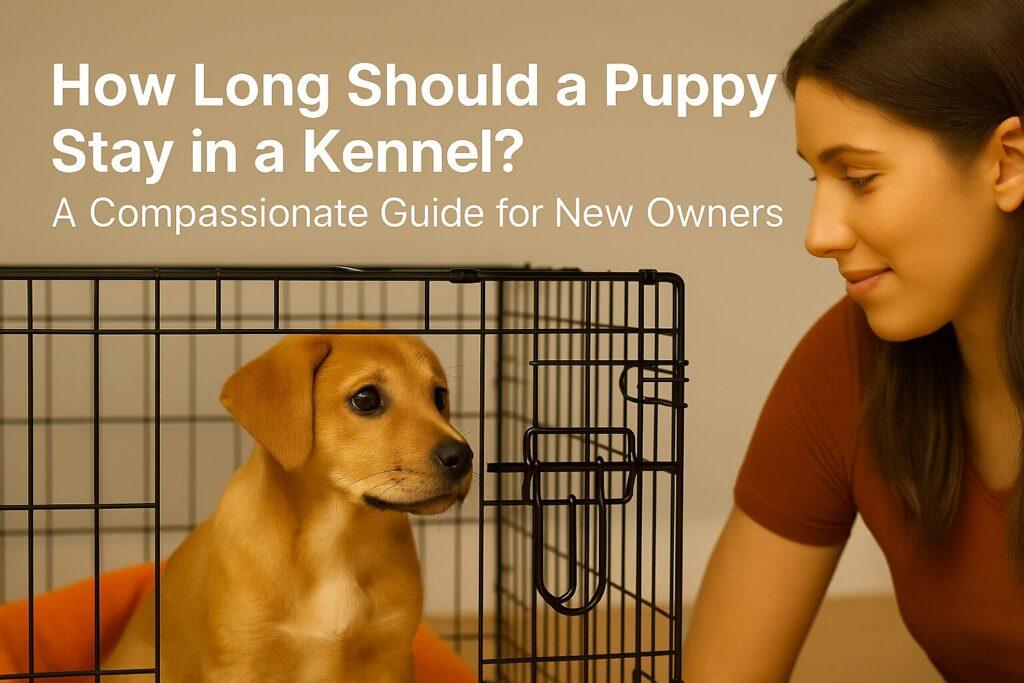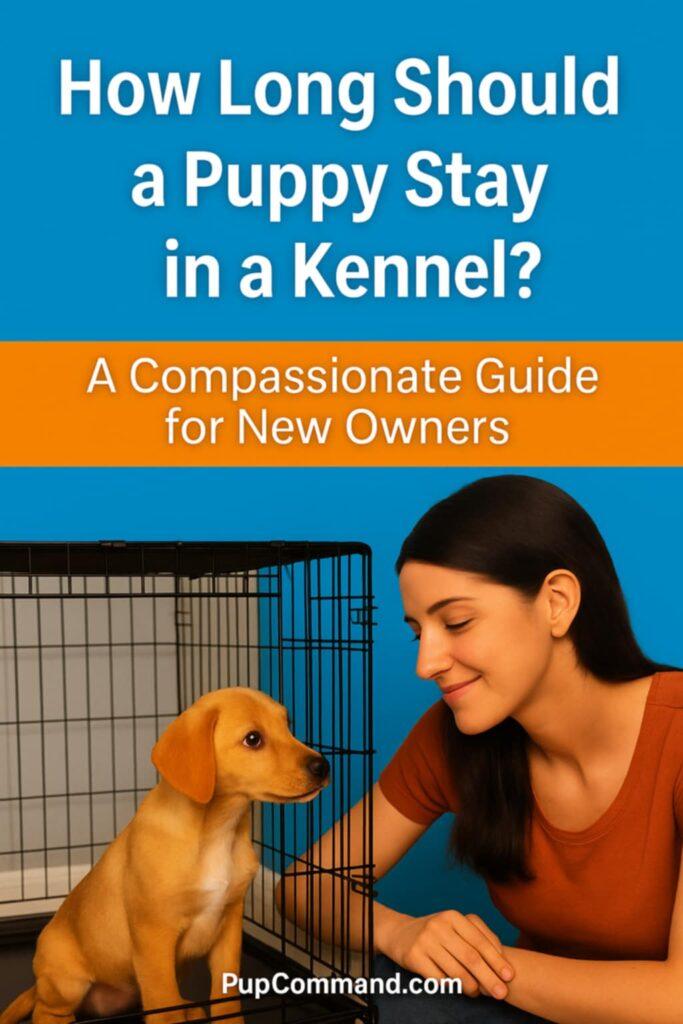
When you bring a new puppy home, crate and kennel training quickly become essential topics. Used correctly, a kennel can provide structure, safety, and comfort. But used without understanding, it can cause stress and confusion—especially for new owners trying to strike the right balance between independence and affection.
How Long Should a Puppy Stay in a Kennel?
So how long should a puppy stay in a kennel? Knowing how long should a puppy stay in a kennel helps prevent overstimulation or neglect.
In this guide, we’ll explore exactly how long should a puppy stay in a kennel based on age, needs, and daily routine. You’ll also learn how to use positive reinforcement to make every moment in the kennel feel safe and rewarding.
Crate vs. Kennel: What’s the Difference?
First, let’s clarify the terms. While they’re often used interchangeably, there’s a small distinction:
- Crate: A smaller, portable enclosure typically kept inside the home. Often used for short-term rest, house training, or sleep.
- Kennel: Can refer to a crate or a larger, more permanent enclosure—either indoors or outdoors. Sometimes used for longer periods when dogs can’t be directly supervised.
In this article, we’ll refer to both under the term kennel, since the principles apply to any safe, enclosed space intended for positive containment.
Why Use a Kennel at All?
Kennels are not cages of punishment. When introduced with positive reinforcement, they become:
- A place for naps and decompression
- A tool for house training
- A management tool to prevent destructive behavior
- A predictable, structured retreat for overstimulated puppies
- A safe space when owners are away or sleeping
But the benefits only come when kennel time is kept age-appropriate, balanced, and rewarding.

How Long Can a Puppy Stay in a Kennel?
There’s no one-size-fits-all number. The ideal kennel duration depends on:
- Your puppy’s age and bladder control
- Their emotional comfort level in the kennel
- The type of kennel use (nap vs. overnight vs. daytime containment)
- Their daily routine—exercise, training, bonding, enrichment
Let’s break it down by age and scenario.
General Kennel Duration Guidelines by Age
| Puppy Age | Max Daytime Kennel Time | Max Overnight Kennel Time | Notes |
|---|---|---|---|
| 8–10 weeks | 30–60 mins | 2–3 hour stretches | Expect potty trips every few hours |
| 11–14 weeks | 1–2 hours | 3–4 hour stretches | Begin extending overnight slowly |
| 15–20 weeks | 2–3 hours | 4–6 hour stretches | Stronger bladder, longer naps possible |
| 5–6 months | 3–4 hours | 6–7 hours max | Still needs breaks and enrichment during day |
| 7+ months | 4–5 hours (daytime) | 7–8 hours (nighttime) | Adult crate limits if well-trained and content |
These are maximum durations—not daily targets. Puppies still need plenty of free time, social time, play, and mental stimulation between kennel sessions.
Understanding Physical and Emotional Limits
Bladder Capacity
A puppy’s bladder is the first limiting factor. The general rule:
Puppy age in months + 1 = hours they can hold it (max)
So, a 2-month-old puppy may only hold it for 3 hours, tops. Holding longer than this can cause:
- Stress
- Accidents
- Setbacks in house training
- Long-term aversion to the crate
Even at night, young puppies may need one or two potty trips until their bodies mature.
Emotional Tolerance
Even if your puppy physically can stay in the kennel for several hours, that doesn’t mean they should. Emotional readiness is just as important.
If a puppy panics, cries, or resists the crate:
- They’re not yet ready for long durations
- The crate needs to be re-associated with safety and reward
- More short sessions with positive reinforcement are needed
Never force kennel duration as a test of willpower. It’s a training process, not a control tactic.
When Should You Use the Kennel?
✅ Great Times to Use a Kennel:
- Naptime: Puppies sleep 16–20 hours a day. Kennels help create peaceful rest zones.
- After meals or play: Puppies are more likely to settle and digest calmly.
- During household chaos: Parties, visitors, or loud cleaning can overwhelm sensitive puppies.
- At night: Teaches sleep routines, bladder control, and independence.
- When you leave briefly: Only once your puppy is ready and feels safe.
❌ Times to Avoid the Kennel:
- As punishment: This damages the trust relationship.
- When puppy is full of energy: Unmet needs lead to frustration.
- For entire workdays: Puppies need interaction and movement throughout the day.
- When emotionally distressed: Crating doesn’t “calm them down”—it often makes anxiety worse.
How to Make Kennel Time Feel Safe and Rewarding
Positive reinforcement isn’t just a training method—it’s the emotional language of safety.
Key Tips:
- Always reward entrance: Treats, toys, praise—make the kennel inviting.
- Feed meals inside the crate: Builds strong positive association.
- Use chews and puzzle toys: These promote calm, happy focus.
- Keep departures neutral: Don’t make leaving dramatic or sad.
- Start small and build: 2 minutes → 10 minutes → 30 minutes → longer durations
- Listen to your puppy: Whining, pacing, or frantic behavior signals discomfort or boredom.
You’re not trying to “crate longer.” You’re trying to crate better.
What If You Work Full-Time?
Many new owners struggle with crate training when their job takes them away for 8+ hours. That’s too long for most puppies to be kenneled without a break.
Options That Help:
- Come home at lunch
- Hire a dog walker or sitter
- Ask a friend or neighbor for a midday break
- Set up a puppy-safe playpen with pee pads and enrichment
- Stagger kennel sessions with supervised free time
The goal is to prevent:
- Overcrating
- Missed potty needs
- Undersocialization
- Emotional withdrawal
Work-life balance applies to puppies, too.
How to Know Your Puppy’s Ready for Longer Stretches
📦 Crate Training Blueprint: Raise a Calm, Confident Puppy
Struggling with barking, reactivity, or nighttime chaos? The root cause often starts in the home environment. This $7 PDF kit gives you the science-based, emotionally attuned strategy to build calm—one crate session at a time.
👉 Download the Crate Training BlueprintLook for signs of confidence:
- Puppy enters the crate willingly
- Settles quickly with a chew or Kong
- Sleeps without whining or barking
- Wakes up calm and rested
- Shows no signs of distress when released
If all of these are true, you can begin extending kennel time by 15–30 minutes at a time every few days.
If any signs of stress return, reduce duration and rebuild trust first.
Looking for veterinary-backed crate and kennel timing advice?
Read the American Veterinary Society of Animal Behavior’s position on confinement and training to understand best practices based on animal welfare science.
How Long Should a Puppy Stay in a Kennel During the Day vs. Night?
Daytime sessions should be brief and frequent, while nighttime kennel time can gradually extend as your puppy matures.
Final Thoughts
So, how long should a puppy stay in a kennel? It’s a question almost every new dog owner asks—and the answer depends on your dog’s age, routine, and comfort level.
Use the kennel as a tool of trust, not confinement. Keep sessions short, frequent, and reward-based in the beginning. Listen to your puppy’s physical and emotional needs.
With consistency, patience, and positive reinforcement, your puppy won’t just tolerate the kennel—they’ll love it.
